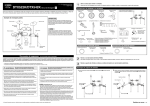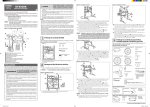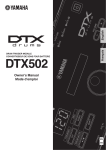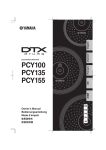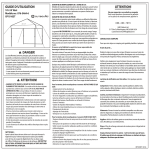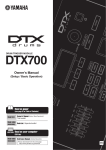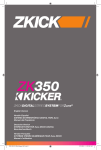Download Yamaha DTX520K Owner`s manual
Transcript
Digital Musical Instruments Division ©2011 Yamaha Corporation WW60810 110PO***.*01C0 DTX540K/DTX520K Assembly Manual EN This pamphlet describes the standard procedure for DTX540K/DTX520K assembly. After assembling the parts and connecting the cords as shown below, you will be ready to turn on the drum trigger module. 1 2 Assemble the RS500 Rack System. For details, refer to the assembly manual that came with the rack system. Check the contents of each package. Package 1: DTP520C PCY135 Cymbal Pad (x1) Example of standard DTX540K assembly HH65 Hi-hat Controller (x1) XP80 Snare Pad (x1) XP70 Tom Pad (x3) Clamp bolts (x4) KP65 Kick Pad (x1) IMPORTANT PCY100 (Cymbal Pad) • For assembly, you will require four individual packages – an RS500 Rack System, a DTP520C Pad Set, a DTP700P Pad Set*, and a DTX500 Drum Trigger Module. (*: The DTX520K uses a DTP520P Pad Set instead.) PCY135 (Cymbal Pad) • This pamphlet describes how to attach the pads and drum trigger module to the RS500 Rack System. Before carrying out the procedures described below, ensure that you have correctly assembled the rack system as described in its assembly manual. XP70 (Tom Pad) PCY100 (Hi-hat Pad) PCY100 Cymbal Pad (x2) Package 2: DTP700P (for DTX540K) XP70 and XP80 Owner’s Manual (x1) KP65 Owner’s Manual (x1) Hi-hat holder (x1) Stoppers for the PCY100 and PCY135 (x3) Felt for the PCY135 (x1) Package 2: DTP520P (for DTX520K) • Although this pamphlet uses illustrations of the DTX540K, the assembly procedures described also apply to the DTX520K. DTX500 Drum Trigger Module XP80 Snare Pad (x1) XP70 (Tom Pad) TP65 Tom Pad (x3) Clamp bolts (x4) KP65 Kick Pad (x1) Felts for the PCY100 (x2) NOTICE Tuning key (x1) Before starting assembly, lay a drum mat (sold separately) on the floor. Alternatively, before setting up the HH65 Hi-hat Controller and KP65 Kick Pad, you can place the packages' cardboard boxes on the floor to protect it from damage. XP80 (Snare Pad) RS500 (Rack System) XP70 and XP80 Owner’s Manual (x1) KP65 Owner’s Manual (x1) TP65, TP65S, TP100, and TP120SD Owner’s Manual (x1) Cable bands (x10) 9-channel snake cable (x1) KP65 (Kick Pad) Package 3: DTX500 DTX500 Drum Trigger Module (x1) AC power adaptor* (x1) Module stand (x1) Module stand fastening screws (x2) HH65 (Hi-hat Controller) PCY100, PCY135, and PCY155 Owner’s Manual (x1) HH65 Owner’s Manual (x1) Assembly Manual (this pamphlet) PRECAUTIONS 3 Before using, please read this assembly manual, and use this product in a safe and proper manner. DTX500 Owner’s Manual (x1) * May not be included depending on your particular area. Please check with your Yamaha dealer. Mount the pads and the drum trigger module on the rack system. As described below, mount the pads and the trigger module on the rack system, and then position the kick pad and the hi-hat controller. * Please keep this manual in a safe place for future reference. Mounting the hi-hat holder * Make sure to read the Assembly Manual of the Rack System and the Owner’s Manual of the Pad. WARNING If this symbol is ignored and the equipment is used improperly, fatal injury to persons or serious damage could occur. CAUTION If this symbol is ignored and the equipment is used improperly, there is a danger or injury to persons handling the equipment, and material damage could occur. • Do not let small children assemble or set up this product by themselves, or they may be injured. Always assemble this product with adult supervision. • Watch your fingers when adjusting clamps. They may become pinched, resulting in injury. • Be careful with the edges of the Cymbal Holders and the Tom Holders. The sharp holder ends may result in injury. • Be careful around pipe ends, inside the pipe and screw ends. Metal shavings, etc. may injure your fingers. • Be careful with the edges of the spurs attached to the Kick Pad and foot pedal. The sharp ends may result in injury. • Do not put your hands or feet under the foot pedal or foot switch. They may be pinched, resulting in injury. • If this product is used with a Rack System or Cymbal Stand, make sure all bolts are tightened firmly. Also, when adjusting the height or angle, do not suddenly loosen the bolts. Loose bolts may result in the rack overturning or parts dropping, causing injury. • Do not attach acoustic drums to the electronic drum rack. Clamps may be damaged and drums may drop, causing injury. • Always set the product on a flat and solid surface. Placement on a sloping, unstable surface or on steps may result in the product being unstable and subject to overturning. • When setting up the product, please pay close attention to the handling and setting of cables. Carelessly placed cables may cause the user and others to trip and fall. • Do not alter the product. Doing so may result in injury or damage/deterioration to the product. • Do not sit or step on the rack. The rack may overturn or be damaged, resulting in injury. 1. Remove the drum trigger module clamp a from the left of the rack, together with the left leg b. 2. Assemble the holder clamp for the hi-hat holder ensuring that it is oriented as shown in the figure, and then reassemble the left leg b and the drum trigger module clamp a. Hi-hat holder Holder clamp Drum trigger module clamp a Drum trigger module clamp a NOTICE • Make sure you hold onto the plug, not the cable, when connecting or disconnecting the cable. Also, never place any heavy or sharp objects on the cable. Applying excessive force to the cable may result in damage to the cable, such as the wires being severed, etc. • Do not step on or place heavy objects on the product. It may result in damage. • Do not use or keep the product in places with extremely high temperature (places in direct sunlight, close to a heater, in a closed car, etc.) or high humidity (bathroom, outside on a rainy day, etc.). Doing so may result in deformation, discoloration, damage or deterioration. • When cleaning the product, do not use benzine, thinner or alcohol as it may result in discoloration or deformation. Please wipe with a soft cloth or a damp cloth that has been wrung out thoroughly. If the product is soiled or sticky, use a neutral detergent on a cloth then wipe with a damp cloth that has been wrung out thoroughly to remove any remaining detergent. Also pay close attention so as not to let the water and detergent come into contact with the cushions used in the product; doing so may result in deterioration. * Specifications and descriptions in this owner’s manual are for information purposes only. Yamaha Corp. reserves the right to change or modify products or specifications at any time without prior notice. Since specifications, equipment or options may not be the same in every locale, please check with your Yamaha dealer. Left leg b Left leg b Continued on other side Mounting snare and tom pads Assembling the kick pad 2. Mount the snare pad on the rack’s clamp rod. As DTX540K: XP70 DTX520K: TP65 shown below, ensure that the rod section is fully inserted into the pad’s mounting hole, and then fully tighten the clamp bolt. Snare pad Clamp rod 1. If a drum mat (sold separately) is not available, lay a sheet of cardboard on the floor to protect it from scratching. As with the snare pad, attach the clamp bolt to each of the three tom pads and provisionally tighten (by 5 or 6 turns). 2. Remove the wing bolts, spring washers, and washers from the kick pad body, and 2. Mount the three tom pads on the rack’s clamp rods. 3. Join the base section to the body as shown right, and then secure it in place by Tom pad Rod section Insert Spring washer Washer Wing bolt line up each set nearby in the order in which it was removed. assembling the wing bolts, spring washers, and washers removed in the previous step from the base side. As shown below, ensure that the rod section is fully inserted into each pad’s mounting hole, and then fully tighten the clamp bolt. Rod section XP80 1. Mounting the tom pad Body Body Clamp rod Base Clamp bolt Support plate Insert Mounting the snare pad 1. Clamp bolt 3. If necessary, use clamp bolts A to E to adjust the height and angle of the snare pad. When doing so, be sure to adjust one bolt at a time (i.e., loosen a bolt, adjust the pad, and then retighten before loosening another). Attach the clamp bolt to the snare pad and provisionally tighten (by 5 or 6 turns). Clamp bolt (to be tightened in the direction shown) 3. If necessary, use clamp bolts A to D to adjust the height and angle of any of the pads. When doing so, be sure to adjust one bolt at a time (i.e., loosen a bolt, adjust the pad, and then retighten before loosening another). Clamp bolt B 4 Position the hi-hat controller and kick pad as desired, referring to the standard assembly example on the other side. 5 Connect the pads to the drum trigger module. NOTICE Before starting assembly, lay a drum mat (sold separately) on the floor. Alternatively, you can place the packages' cardboard boxes on the floor under the hi-hat controller and kick pad to protect it from damage. As described below, connect the output of each pad to the corresponding trigger input jack on the drum trigger module. Clamp bolt B Snare pad (rear side) Clamp bolt D Clamp bolt E 1. Clamp bolt A Clamp bolt A Clamp bolt C Clamp bolt C Clamp bolt D Insert the 9-channel snake cable’s straight plugs into the drum trigger module’s trigger input jacks ([q SNARE] to [i KICK/o] and [HI-HAT CONTROL]). • If you are using the standard setup, the stickers on each of the snake cable’s plugs will indicate the name of the corresponding pad. 2. Plug the 9-channel snake cable’s L-shaped plugs into the correct pads. [Locations of pad jacks] [Drum trigger module’s rear panel] 1 Mounting the drum trigger module, cymbal pads, and hi-hat pad Cymbal pad: PCY100 Cymbal pad: PCY135 Hi-hat pad: PCY100 Mounting the cymbal and hi-hat pads 1. ing full contact with the bottom surface of the bolt cover, tighten the stopper’s key bolt using a tuning key. 4 5 6 7 8 9 Stopper [Cymbal pad] Key bolt [Hi-hat pad] Stopper Bolt cover Bolt cover Tuning key Full contact Full contact 2. Remove the wing nut, the two felt pads, and the bolt cover from the cymbal holder. Wing nut Mounting the drum trigger module Bolt cover Attach the module stand (provided) to the underside of the drum trigger module using the module stand fastening screws. Cymbal holder Module stand fastening screws Module stand Drum trigger module (back side) 3. Place the stopper on the cymbal holder. * If the key bolt was not sufficiently loosened in Step 1 above, it may not be possible to pass the stopper over the cymbal holder’s shaft. In such a case, loosen the key bolt as much as possible without removing it. Front of module tighten the clamp bolt to secure in position. Straight plugs DTX500 jack names SNARE TOM1 TOM2 TOM3 RIDE CRASH HI HAT KICK HH CON 1: qSNARE 2: wTOM1/!0 3: eTOM2/!1 4: rTOM3/!2 5: tRIDE 6: yCRASH 7: uHI-HAT 8: iKICK/o 9: HI-HAT CONTROL 3. In the case of snare and tom pads, wrap the cables around the cable clips to prevent them from being pulled out. 6. Place one of the felt pads removed in Step 2 on the L-shaped plugs cymbal holder. 7. Mount the pad unit on the cymbal stand. Lower the pad unit into place with the cymbal holder’s shaft passing through the central hole of the cup section. When mounted, the stopper’s pin should rest inside the pad unit’s smaller hole. * If you were to play a cymbal pad without the stopper’s pin positioned inside the smaller hole, the pad could rotate, causing the cable to be pulled out. It is very important, therefore, to ensure that the stopper is secured as described in Step 5 above. 8. Assemble the felt pad that came with your pad unit. * The second felt pad removed from the cymbal holder in Step 2 above is not required for assembly of your pad unit. 9. Tighten the wing nut to secure the pad unit to the NOTICE HH CON HI HAT CRASH KICK SNARE TOM1 TOM2 TOM3 RIDE 6 1. Excessive bending can damage the pad cables. Ensure, therefore, that these cables are not bent at an extreme angle when wrapped around the clips. Connect the drum trigger module to a power supply. Ensure that the (Standby/On) button is set to the Standby position, and then connect the AC power adaptor to the DC IN jack on the rear panel. Hook the power adaptor’s cord around the cord clip to secure it in place. [Drum trigger module’s rear panel] DC IN jack Cord clip cymbal holder. 4. Replace the bolt cover. 2. Place the module stand inside the holder clamp and [9-channel snake cable] Straight plug names (as shown on stickers) Cymbal holder Felt pads Stopper’s pin Bolt cover Wing nut Pad unit Felt pad that came with pad unit Smaller hole 2. Use the cable bands to bind the cables to the rack as shown on the right. ( ) Stopper Drum trigger module + module stand Pad unit Cymbal holder Insert Clamp bolt 3 5. Secure the stopper in place. With the stopper mak- Using a tuning key, loosen the stopper’s key bolt. Drum trigger module 1. 2 Felt pad Bolt cover Holder clamp 3. Plug the AC power adaptor into an AC wall socket. Pin Stopper * When assembling the bolt cover, turn until it no longer rotates. Cymbal holder This completes the assembly procedure. * For information about tuning the power on/off, checking the actual sound, and other subsequent steps, refer to the Setting Up section of the owner’s manual that came with your drum trigger module.
This document in other languages
- română: Yamaha DTX540K
- français: Yamaha DTX540K
- español: Yamaha DTX540K
- Deutsch: Yamaha DTX540K
- русский: Yamaha DTX540K
- Nederlands: Yamaha DTX540K
- dansk: Yamaha DTX540K
- polski: Yamaha DTX540K
- čeština: Yamaha DTX540K
- svenska: Yamaha DTX540K
- italiano: Yamaha DTX540K
- português: Yamaha DTX540K


